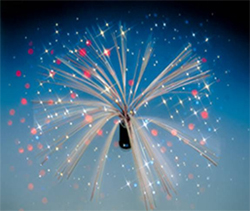
 |
||
|
::: Charles K. Kao, NTU's former chair professor by special appointment, wins the Nobel Prize in Physics |
||
 A section of a typical fiber optics(black). It contains at least 1000 fiber optics. Every piece of fiber optics can carry opto-electrical signals, and the rate of transmission is over 1000 billion bits. Do you know how many bits of information a color film contains? And how come such large volumes of information can be downloaded to your laptop almost instantaneously? The relay of messages, or communication, if you will, has almost been a core of human civilization. Fiber -optic communication uses light to replace electricity, and is a revolutionary invention which uses fiber optics to transmit information. Owing to its ultra high capacity (meaning high bandwidth), its non-interference characteristics, and its long distance transmission features, fiber optic is largely used in the next generation communication networks, and becomes the foundation for today's networks, even amplified in the diversified functions of the internet.. The successful excellence of fiber optics technology results in the convergence of telecommunications, information, and video networks, and enables voice, data, video, animation, film, music, and multi-media and a variety of different forms of information to blend seamlessly into the internet, thus introducing the digital network of today. Large amounts of information can be transmitted around the globe in an instant, so it shouldn't be hard to imagine the contribution that fiber optics communication made to the world civilization and to the welfare of mankind. Known as "father of fiber-optics" internationally, Dr. Charles K. Kao first proposed to use light to replace electricity to transmit information and to find the technology thereof in 1966. As the jury of the Nobel Prize pointed out, the fiber optical technology proposed by Dr. Charles Kao brought tremendous benefits for mankind. If we were to tear open the fiber optics that spread all over the world today, and pull them into a straight line, the length of which would be more than 1 billion kilometers, enough to circulate the earth 25,000 times. Today, thousands of kilometers of fiber optics are increasing by the hour. Fiber optics lay an important foundation for the internet society of today, and as such is a ground-breaking achievement. Dr. Charles K. Kao, the recipient of the Novel Prize in Physics, had close ties with the University. From the year 2003, the Electronics Institute of the College of Electrical Engineering and Computer Science enlisted Dr. Charles K. Kao as a chair professor by special appointment, and asked Dr. Kao to guide research at NTU. Additionally, the colleagues of the College of Electrical Engineering and Computer Science, when they hosted the IEEE Globecom 2002 in Taipei, had asked Dr. Charles K. Kao as the keynote speaker. The faculty and students at NTU all shared Dr. Charles k. Kao's joy in winning the Nobel Prize. Dr. Kao was born in mainland China. Throughout his undergraduate and graduate studies he majored in Electrical Engineering. As a bona fide electrical engineer, he nevertheless was able to obtain the highest prize in physics, This is a feat that we can only aspire to. While we share Dr. Kao's joy in winning the Nobel Prize, we also hope that our students and faculty can emulate Dr. Kao's spirit in pursuing new knowledge and new technology, and render great contributions to the livelihood of mankind as well. |
||
No. 1, Sec. 4, Roosevelt Road, Taipei, 10617 Taiwan(R.O.C.)
Phone: +886-2-3366-3366 Fax: +886-2-2362-7651